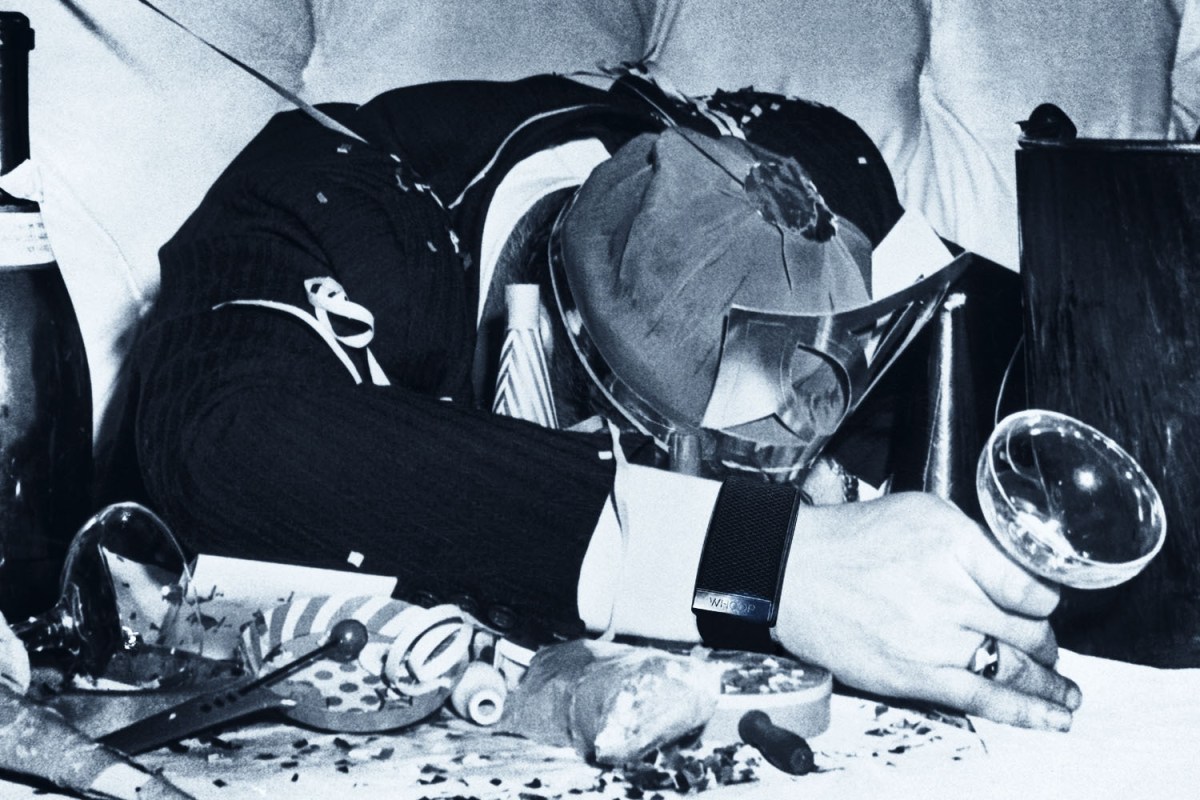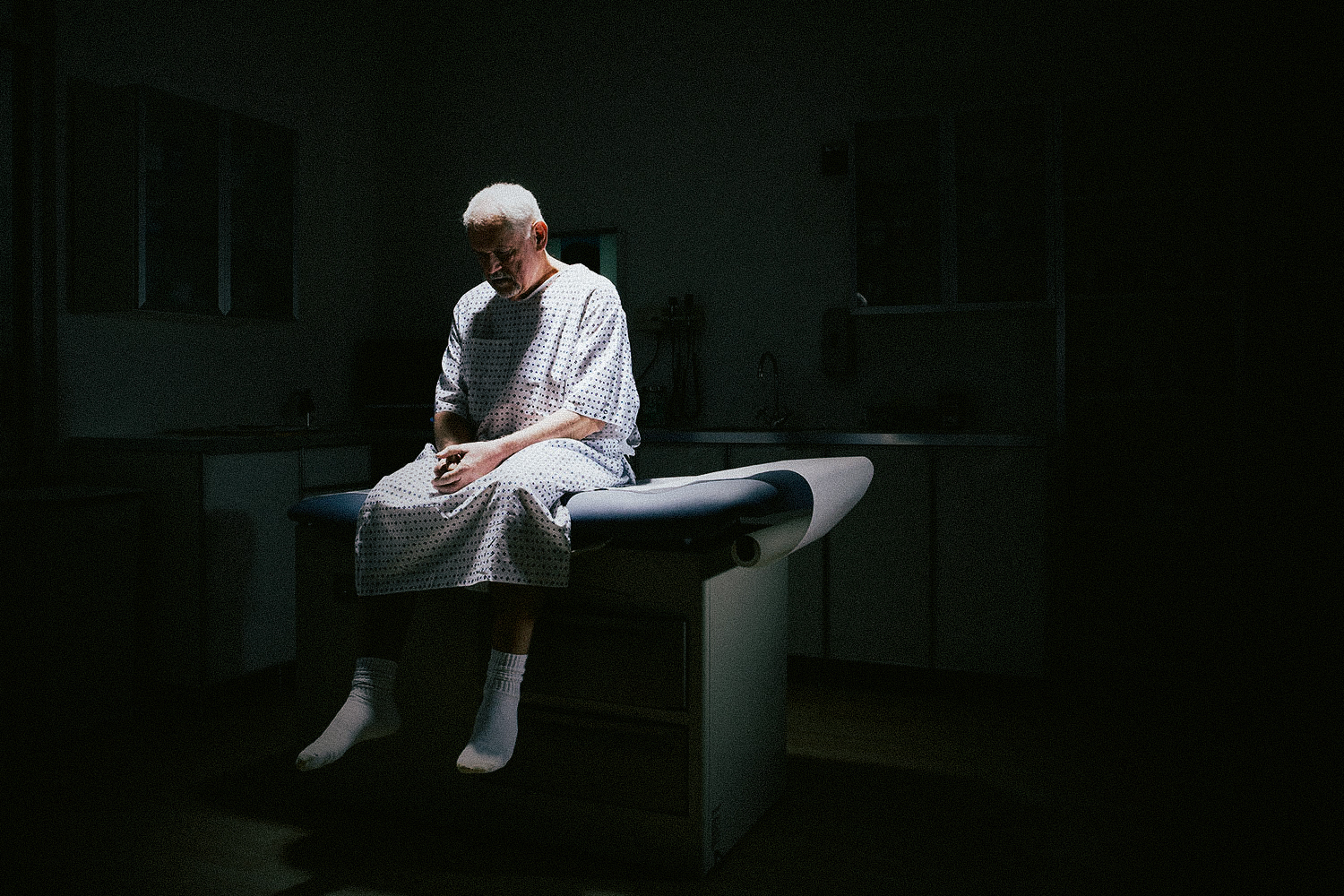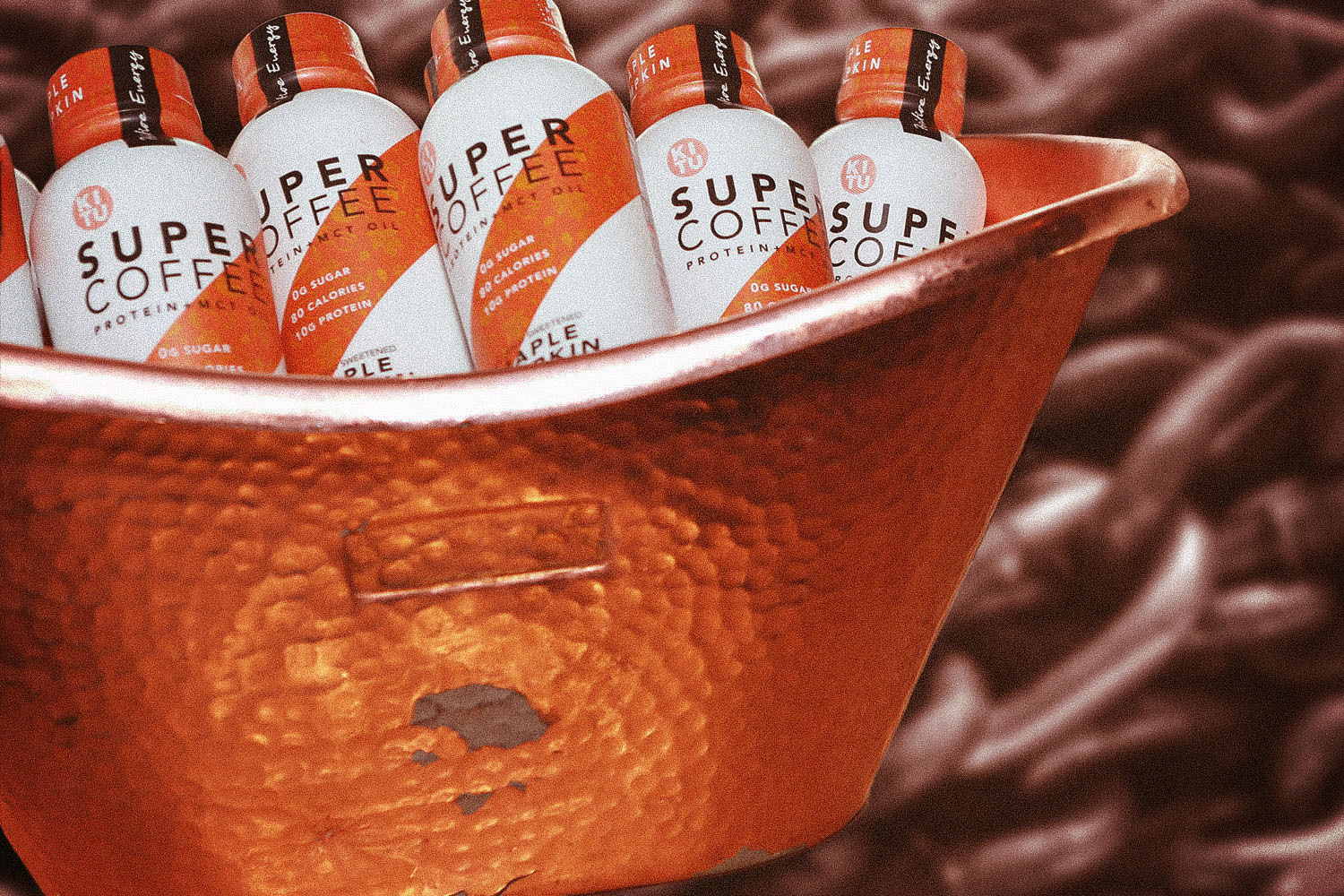About once a weekend I run into someone else who wears a WHOOP.
When I spot one in the wild at the gym or on a golf course I don’t think much of it; the wearables blend in amid exercise and activewear. But they’re super noticeable at the bar on a Saturday afternoon. During an NFC Divisional game a couple weeks ago, while waiting for the bartender to top off my Guinness, I chatted biometrics with a stranger on the stool next to me.
The first thing he wanted to commiserate over — the first thing every WHOOP-wearer wants to discuss — was my most recent “worst recovery.” WHOOP computes a percentage score each morning, predicated on the quality of your sleep and whatever level/intensity of activity (something the platform calls “strain”) that you put in the day before. We both confessed to poor scores after fun Friday nights. I’d woken up with a 34%. He’d logged a 13%.
That was about it. We laughed about our bad decision-making, clinked glasses and went our separate ways. I’ve experienced similar interactions throughout my first 12 months of wearing WHOOP. There’s either a gallows humor regarding just how negative of an impact drinking appears to have on sleep, or a total disassociation from that information — a couple friends have told me they purposefully allow their WHOOP bands to lose battery as the weekend approaches so they don’t have to know the bodily cost of the beers.
For those in the former camp, it’s easy to treat WHOOP’s trademark “recovery” rating like a trifling, almost-fabricated figure. After all, it’s not like every non-WHOOP-wearing person you bump into throughout the day knows their recovery percentage off the top of their head. From this perspective, the number can feel like a construct, a redundant reminder that you feel like shit. You can trust whatever advanced mathematics your WHOOP is using to find the percentage, but sometimes, you’d rather just ignore it.
The issue with that, as I’ve come to realize over the last year, is daily use of WHOOP compels an inevitable familiarity with all the biomarkers that feed into that percentage. The platform tracks respiratory rate, blood oxygen, resting heart rate, heart rate variability … even skin temperature and sleep disturbances. Those numbers do mean something, even on days you don’t want them to.
As I’ve grown accustomed to my acceptable range for each statistic, I’ve woken up flabbergasted by what happens to them when I hit the hay hammered. Below, I’ve included a look at the disparity in that data. I’ve chosen back-to-back nights, each from a week ago, to adjust for long-term shifts in my biometrics. One (the red-shaded image) was after a night of drinking. The other (the green-shaded image) was the following night, following my usual, sober wind-down routine.
The Good:
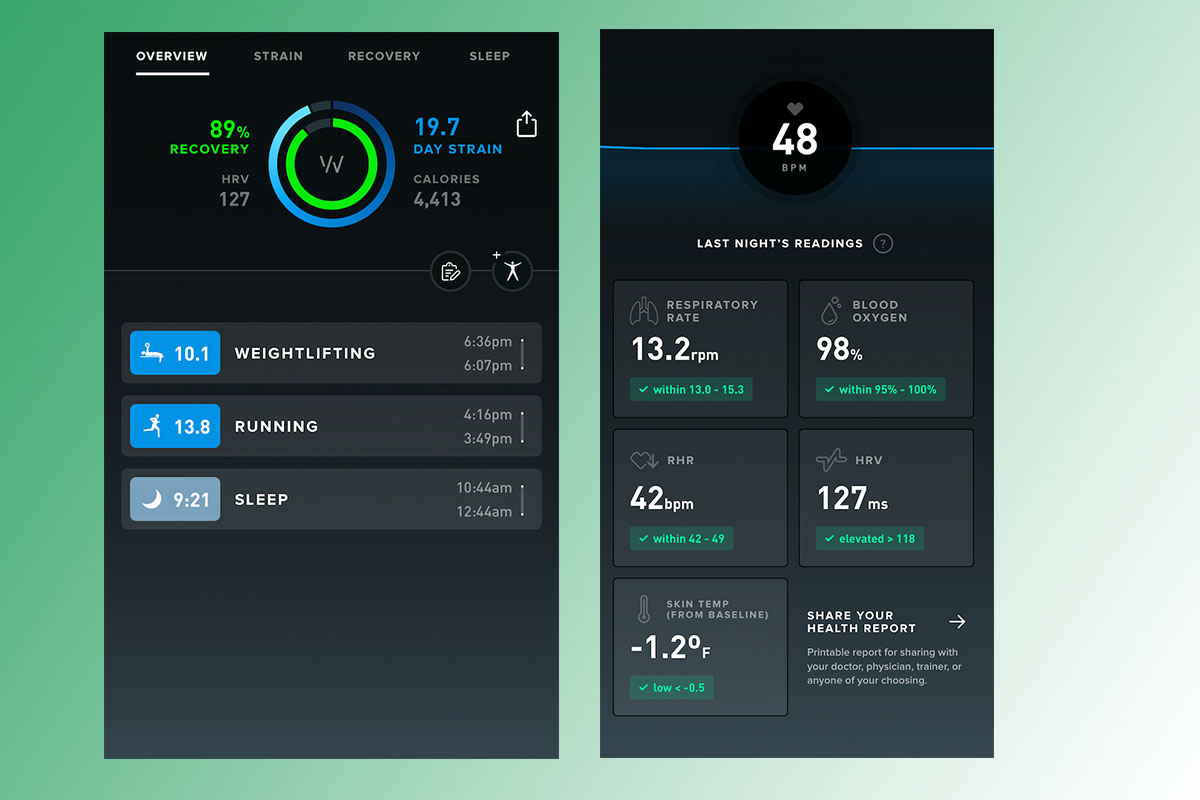
As my personal WHOOP statistics go, it doesn’t get much better than that. I slept for over nine hours, during which (according to the app) “20.7% of [my] time asleep was spent in deep sleep, which is an optimal amount for adults.” My respiratory rate was on the lower end of its usual range, indicating a steady number of breaths per minute, my blood oxygen was the highest I’ve ever seen it, and my heart was really taking it easy. Note that the resting heart rate is quite low, at just 42 beats per minute.
I remember taking the right-side screenshot in the “good” image just after I woke up. Normally, when we wake up, heart rate dramatically increases. There’s a reason we hate our alarms. The sound rips us from our last cycle of REM sleep and into the reality of another day being alive, so it’s natural for the heart to immediately start working harder. But I documented that schematic because I was surprised to see how calm my heart was, even upon waking up. It was hanging out in the high forties (I captured it at 48), as I rubbed my eyes and stretched my arms. It was definitive confirmation of what I’d woken up thinking: that had been one good-ass sleep.
You’ll notice that I really took advantage of the successful sleep by loading up on exercise. I burned nearly 4,500 calories that day, between a four-mile run and an hour in the gym. Remember: while increasingly a product for people who watch football in bars on the weekend, WHOOP was originally conceived for those playing football — or tennis, or competing in mixed martial arts, or training for combat with a platoon. The app isn’t just informational, it’s instructive. Elite athletes basically have a permission slip to train hard, assuming their bodies were able to rest and recover from the previous day.
This is where the recovery percentage begins to mean something. I could say I had 89% recovery, and yeah, that sounds really promising. But it’s when you look at all the other metrics — especially the 127 milliseconds in variance between my heartbeats (the physiological measurement known as heart rate variability) — that you have irrefutable proof that your body is ready to do things to get better. I’m not an elite athlete. But I like to train hard and try to improve within my own concentrations; in order to do that safely and effectively, I try to assume the mentality of an elite athlete.
(It’s another reason why the “no days off” ethos frequently pedaled by weekend warriors is self-defeating. Waking up before dawn for a workout, no matter what, is also dumb. At the very least, your body needs a good night’s sleep.)
Add alcohol to the mix, though, and all bets are off. Let’s take a gander at the second image above, the red “bad” night.
The Not So Good:
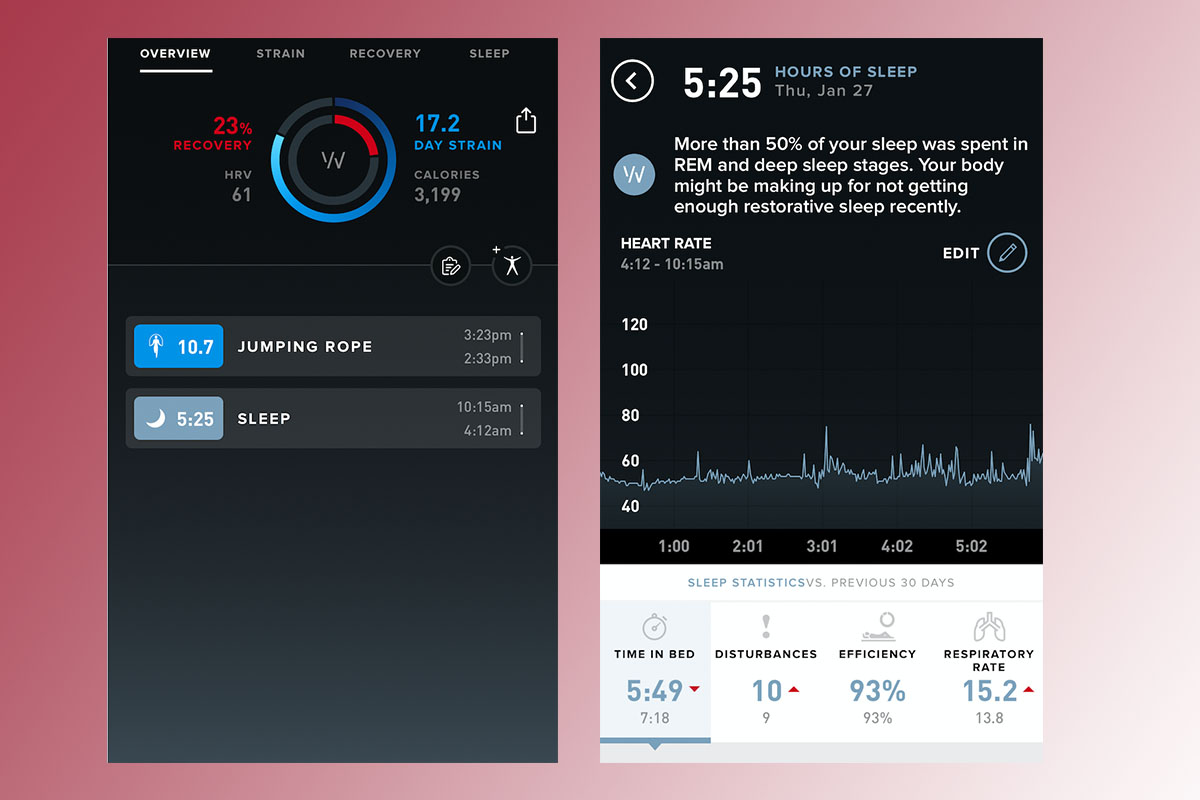
For starters, a disclaimer: I went to bed really late here. I postgamed the postgame. That did not help my recovery percentage or the overall “look” of these numbers. A measly five hours of sleep is never going to go the distance the next day, even if you only drank water before bed. But, consider: A) the mere fact I was up that late is because I was drinking, and B) if your idea of a boozy night is four or five Bud heavies, a movie, then straight to bed, that alcohol is still going to have its say on your sleep.
My respiratory rate indicates I was averaging two extra breaths a minute. A “normal” range for adults tops out at 16 respirations. Here, at 15.2 rpm, I was flirting with that cap. When I comb through months and months of WHOOP data, there are only two clear situations in which my breath gets labored as I sleep: when I drink and when I’m sick. Now, if you’re dealing with a respiratory illness, that stat can really come in handy. When I spoke to WHOOP founder and CEO Will Ahmed last year, he proudly filled me in on how his company has actually sniffed out COVID cases for users before they officially test positive.
When that heightened figure shows up after a night out, though, all it’s saying is that my body struggled to do what it’s designed to do while I sleep. There’s are common misconceptions around what the body’s up to while we sleep — probably because we blithely throw around terms like “pass out.” We imagine it sort of idling like a car until we’re ready to use it again. You cozy up in a bed, have a dream or two, then wake up feeling somewhat refreshed. But it’s the opposite. So many things happen when you sleep.
Your brain sorts and processes all the things you saw and learned that day (one reason cramming for tests and presentations isn’t a great idea); the pituitary gland floods the body with growth hormone, which helps your muscles repair and strengthen; your immune system ships small proteins around the body, meant to fight inflammation and infection; and the sympathetic nervous system finally gets a chance to take a lap and cool down, as blood pressure drops and cortisol release decreases. As WHOOP’s Vice President of Data Science and Research, Emily Capodilupo, says: “Sleep is an incredibly active process, our bodies are working really, really hard when we sleep, and if you have alcohol in your system, none of those very active processes can happen.”
It’s tempting to view alcohol as an effective sedative, especially for those who struggle with falling asleep. It’s an undefeated sleeping potion. But as Dr. Jennifer Martin, a UCLA professor of medicine recently explained to The New York Times, alcohol wreaks havoc on the back nine of your sleep: ““You pay for it in the second half of the night,” she said. “[Alcohol is] initially sedating, but as it’s metabolized, it’s very activating.” When the body should be investing its time and energy in all those magical processes outlined above, it’s instead devoting time to processing alcohol.
At the same time, alcohol is actively sabotaging many of those processes. It disrupts the architecture of your sleep, waking you up from your own severe snoring (by messing with the muscles in your airways), or to pee (it’s a diuretic) or in reaction to a stressful dream (they’re more vivid/insane after a night of drinking).
The one figure I always see fall off a cliff after a night of drinking — other than amount of hours spent in bed — is my heart rate variability. HRV is a tricky stat, which is best monitored against your own trends and not against those of other people, but know that it drops as we age, and overall, a higher HRV is a surefire predictor for good fitness. Here’s WHOOP’s definition: “When you have high heart rate variability, it means that your body is responsive to both sets of inputs (parasympathetic and sympathetic). This is a sign that your nervous system is balanced, and that your body is very capable of adapting to its environment and performing at its best.”
It’s a precise demonstration of your body’s physiological reaction to stress. Bodies with high HRV respond in a dynamic way to their environment, knowing when to work hard and when to take the foot off the pedal. Whenever I drink, my HRV turns ugly. It was 127 after the “good” night. It was just 61 after the “bad” night. That’s a preposterous disparity — and it probably speaks to just how much I had to drink for the “bad” night. But consider this: on average, HRV drops by 7ms for WHOOP users after a night of drinking. And one drink counts as “drinking” here. The same criteria corresponds to a 8% decrease in recovery percentage.
WHOOP has other data on the relationship between alcohol intake, sleep quality and performance, because of course they do. It ranges from how healthy just two weeks of sobriety can make you, to exactly how long alcohol stays in your system (hangovers can technically last for four full days, believe it or not). The point of this data is not to spook you, or me, or anyone. What it does suggest is that if you have the desire or capability to cut out alcohol, you should absolutely see where that road takes you.
The real purpose is to arm yourself with information. It’s fun to laugh about recovery percentages with a stranger in the bar, as if they aren’t real, but that “fuck it” attitude is the real fabrication. How you feel after a night of drinking is no lie — and thanks to this crazy age we live in, there’s now hard data to quantify it.
In researching this piece I came across a commenter on Reddit who’s been forced to face some hard truths. He wrote: “I’m trying to make a lot of healthier lifestyle changes right now … I’m a pretty heavy drinker, which is something I’d like to change, so for a week I wore WHOOP while keeping my regular drinking each night and then going harder on weekends. Needless to say, my stats are trash. My RHR is super high, HRV is low, recovery is never above 25%, and I’m currently operating at about 45% sleep performance. If this is how my body functions normally, that’s pretty terrible. This has been a huge motivator for me to cut alcohol out of my life and get my stats up.”
His story seemed to strike a chord with others in the subreddit. He titled it “Thankful that WHOOP really shows you what alcohol does to your body.” These might’ve originally been designed with Kevin Durant and Rory McIlroy in mind, but that right there is what it’s all about.
As for me, I’ve learned one other crucial lesson. I’d like to let my WHOOP run out of charge right before a bender, but it’s important to know how depleted my body is. See that little “jumping rope” icon in the “bad” photo? Those were the delusional hops of a hungover man determined to prove he could get 45 minutes of exercise in. It was, without one shred of a doubt, my worst workout of the year.
The Charge will help you move better, think clearer and stay in the game longer. Subscribe to our wellness newsletter today.
